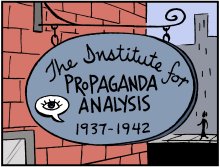 Introduction The Institute for Propaganda Analysis Previous | Next | Index  |
This site is inspired by the pioneering work of the Institute for Propaganda Analysis (IPA). In 1937, the IPA was created to educate the American public about the widespread nature of political propaganda. Composed of social scientists and journalists, the IPA published a series of books, including:
Some argue that the IPA's approach is too simplistic because many messages fall into more than one category. The IPA techniques have also been criticized because they do not account for differences between members of the audience, and they do not discuss the credibility of the propagandist. There is some validity to these criticisms, but few could quibble with the IPA's basic goal of promoting critical thought among citizens. In The Fine Art of Propaganda, the IPA stated that "It is essential in a democratic society that young people and adults learn how to think, learn how to make up their minds. They must learn how to think independently, and they must learn how to think together. They must come to conclusions, but at the same time they must recognize the right of other men to come to opposite conclusions. So far as individuals are concerned, the art of democracy is the art of thinking and discussing independently together." |
| Comments to author: [email protected] |